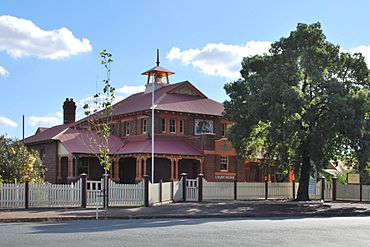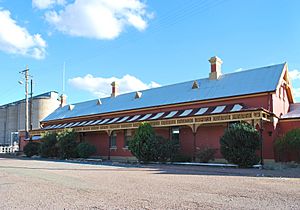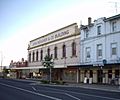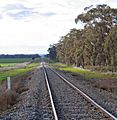Temora, New South Wales facts for kids
Quick facts for kids TemoraNew South Wales |
|||||||||
|---|---|---|---|---|---|---|---|---|---|

Temora Court House, built in 1902
|
|||||||||
| Population | 4,016 (2021 census) | ||||||||
| Postcode(s) | 2666 | ||||||||
| Elevation | 302 m (991 ft) | ||||||||
| Location |
|
||||||||
| LGA(s) | Temora Shire | ||||||||
| County | Bland | ||||||||
| Parish | Bundawarrah | ||||||||
| State electorate(s) | Cootamundra | ||||||||
| Federal Division(s) | Riverina | ||||||||
|
|||||||||
Temora is a town in the north-east of the Riverina area of New South Wales, Australia. It is about 418 kilometers (260 miles) south-west of Sydney, the state capital. In 2021, about 4,016 people lived in Temora.
The town was named by John Donald McCansh. In 1880, he explained that he started a sheep farm there in 1847. He couldn't find a local Aboriginal name for the place. So, he named it 'Temora' after another property he knew. He liked that it was an Aboriginal name. Later, he learned that 'Temora' was also a name in old poems by Ossian.
Some people think "temora" means "a tree standing alone" in the Dharug language. Others believe it comes from a Celtic word meaning "a high place with a wide view."
Contents
Geography
Temora is located in the north-eastern part of the Riverina region of New South Wales. It is also part of the South West Slopes. The town is about 302 meters (991 feet) above sea level. The land around Temora is mostly flat or gently rolling. To the north, you can find the Narraburra Hills and the Boginderra Hills Nature Reserve.
Temora is about 90 kilometers (56 miles) north of Wagga Wagga. It sits on two important roads: the Burley Griffin Way, which connects Canberra and Griffith, and the Goldfields Way, which links Albury and Wagga Wagga to the Newell Highway.
Climate
Temora has a warm climate. Winters are cool and a bit wet, while summers are hot and dry.
Winter Weather
Winters in Temora are cool. The average high temperature in July is about 13.0°C (55.4°F). The average low temperature is about 2.1°C (35.8°F). It can get quite cold, with the lowest temperature ever recorded being -6.8°C (19.8°F) in August 2018.
Summer Weather
Summers are hot and dry. Average high temperatures are between 29.6°C and 31.5°C (85.3°F and 88.7°F). The average low temperatures are between 13.8°C and 16.2°C (56.8°F and 61.2°F). The hottest temperature ever recorded was 46.4°C (115.5°F) in January 2020.
| Climate data for Temora Research Station (1934–2005); 270 m AMSL; 34.41° S, 147.52° E | |||||||||||||
|---|---|---|---|---|---|---|---|---|---|---|---|---|---|
| Month | Jan | Feb | Mar | Apr | May | Jun | Jul | Aug | Sep | Oct | Nov | Dec | Year |
| Record high °C (°F) | 46.4 (115.5) |
45.0 (113.0) |
40.1 (104.2) |
35.8 (96.4) |
27.9 (82.2) |
24.0 (75.2) |
23.9 (75.0) |
27.1 (80.8) |
33.9 (93.0) |
37.1 (98.8) |
43.0 (109.4) |
43.8 (110.8) |
46.4 (115.5) |
| Mean daily maximum °C (°F) | 31.5 (88.7) |
30.8 (87.4) |
27.8 (82.0) |
22.5 (72.5) |
17.8 (64.0) |
13.9 (57.0) |
13.0 (55.4) |
14.8 (58.6) |
18.2 (64.8) |
22.0 (71.6) |
26.0 (78.8) |
29.7 (85.5) |
22.3 (72.2) |
| Mean daily minimum °C (°F) | 16.0 (60.8) |
16.2 (61.2) |
13.3 (55.9) |
9.0 (48.2) |
5.6 (42.1) |
3.2 (37.8) |
2.1 (35.8) |
3.0 (37.4) |
4.7 (40.5) |
7.7 (45.9) |
10.6 (51.1) |
13.8 (56.8) |
8.8 (47.8) |
| Record low °C (°F) | 4.7 (40.5) |
4.2 (39.6) |
1.9 (35.4) |
−3.1 (26.4) |
−4.6 (23.7) |
−5.3 (22.5) |
−6.4 (20.5) |
−6.8 (19.8) |
−4.5 (23.9) |
−3.0 (26.6) |
−1.0 (30.2) |
3.4 (38.1) |
−6.8 (19.8) |
| Average precipitation mm (inches) | 46.0 (1.81) |
40.2 (1.58) |
40.4 (1.59) |
41.1 (1.62) |
41.8 (1.65) |
43.1 (1.70) |
46.3 (1.82) |
45.0 (1.77) |
42.1 (1.66) |
52.2 (2.06) |
46.2 (1.82) |
41.3 (1.63) |
525.7 (20.71) |
| Average precipitation days (≥ 0.2 mm) | 5.6 | 5.0 | 5.1 | 6.0 | 8.6 | 10.6 | 12.7 | 11.6 | 9.3 | 8.9 | 6.9 | 6.0 | 96.3 |
History
Temora began as a sheep farm in 1847. Later, gold was found nearby, and a small village grew. The Temora Post Office first opened in 1874.
Gold was first discovered in the area in 1869. A big gold rush started in 1879, bringing over 20,000 people to the gold fields. The area was officially declared a gold field in June 1880. Even with dry weather, Temora produced half of the state's gold by 1881. In that year, the gold field had its highest yield, an impressive 35,228 ounces.
Some very large gold nuggets were found. One famous one was the Mother Shipton nugget, which weighed over 308 ounces. A copy of it is at the Temora Rural Museum.
When the gold mining slowed down, Temora's population quickly dropped. By 1911, about 2,784 people lived there.
The Temora railway station opened in 1893.
In the early 1900s, many people of German background settled in Temora and nearby areas like Trungley Hall. This is why you can find many German road names there.
More recently, gold mining happened at the Paragon Gold Mine, 12 kilometers (7.5 miles) north of town, from 1986 to 1996.
| Historical population | ||
|---|---|---|
| Year | Pop. | ±% |
| 1921 | 3,048 | — |
| 1933 | 3,823 | +25.4% |
| 1947 | 5,423 | +41.9% |
| 1954 | 4,567 | −15.8% |
| 1961 | 4,469 | −2.1% |
| 1966 | 4,536 | +1.5% |
| 1971 | 4,466 | −1.5% |
| 1976 | 4,324 | −3.2% |
| 1981 | 4,350 | +0.6% |
| 1986 | 4,295 | −1.3% |
| 1991 | 4,279 | −0.4% |
| 1996 | 4,125 | −3.6% |
| 2001 | 4,146 | +0.5% |
| 2006 | 4,086 | −1.4% |
| 2011 | 3,874 | −5.2% |
| 2016 | 4,054 | +4.6% |
| 2021 | 4,016 | −0.9% |
| Source: Australian Bureau of Statistics data. | ||
Heritage Sites
Temora has several places that are listed as heritage sites. This means they are important historical locations. These include:
- The Cootamundra-Griffith railway: Temora railway station
- 173 Hoskins Street: Temora Post Office
Economy and Attractions
Agriculture
Temora is a major farming area in southern New South Wales. It produces a lot of wheat, canola, other grains, and wool. It also has the second largest honey producer in Australia.
Many businesses in Temora support farming. These include places for storing grain and wool, shops that sell and fix farm equipment, and companies that provide chemicals and fertilizers.
Tourism
Temora has several interesting places to visit:
- The Temora Aviation Museum has many old aircraft. It even has Australia's only two flying Spitfires.
- The Temora Aero Club is at Temora Airport. Here, people can learn to fly different types of planes and gliders.
- The Bundawarrah Centre includes a rural museum. It shows what life was like in the countryside. You can see Sir Donald Bradman's first home, an old school, a bush church, and more.
- Lake Centenary is a man-made lake north of town. It's a great spot for water sports like boating, waterskiing, sailing, and swimming. It has picnic areas and a boat ramp.
Education
Temora has two public primary schools, one public high school, and one Catholic school. There is also a TAFE campus for further education.
- Temora High School opened in 1952. It is known for its strong academic and sports programs. It often gets some of the best HSC (high school) results in the Riverina area.
- Temora Public School is well-known for its successful academic, sports, and cultural programs. It is located in the center of town.
- Temora West Primary School opened in 1959. It serves students from Temora and surrounding smaller areas.
- St Anne's Central School in Temora teaches students from Kindergarten up to Year 10.
- TAFE NSW Riverina Institute has a campus in Temora. It moved to a new location in 2010.
Transport
Roads
Temora is located where two main roads meet: the Goldfields Way and the Burley Griffin Way. The Goldfields Way runs north and south, connecting Wagga Wagga to West Wyalong. It's a key route between Albury and Brisbane. The Burley Griffin Way links Griffith to the Hume Highway near Yass.
Rail
Temora railway station is on the Lake Cargelligo railway line. It opened in 1893. The station used to be a place where passengers could transfer to other services. While there are no regular passenger trains now, it's still important for train signaling. The Lachlan Valley Railway sometimes uses it, and the local council is restoring it for tourism.
The Lake Cargelligo railway line is mainly used for carrying grain. The Temora–Roto railway line also branches off here, connecting to Griffith and Hillston.
Air Travel
Temora Airport can handle many types of aircraft, from small planes to larger airliners. There are no regular passenger flights at the airport right now. Besides the aviation museum, the airport also has a unique housing area where people have built homes with airplane hangars in their backyards!
Public Transport and Cycling
You can travel to Temora by train and bus. NSW TrainLink trains go from Sydney and Melbourne to Cootamundra. From there, a connecting bus takes passengers to Temora.
Temora has a special off-road bicycle track that goes from the town to Lake Centenary. There are also some bicycle tracks on the roads within the town.
Sport
Sport is a big part of life in Temora. The most popular sport is rugby league. The town used to compete for the famous Maher Cup.
Here are some of the sports clubs in Temora:
- Temora Basketball Association
- Temora Bowling and Recreation Club
- Temora District Cricket Association
- Temora Dragons Rugby League Club
- Temora Golf Club
- Temora Greyhound Racing Club
- Temora Harness Racing Club
- Temora Little Athletics
- Temora Kangaroos - AFL & Netball
- Temora Rugby Union Club Inc
- Temora Swimming Club
- Temora Town Tennis Courts
- Temora United Soccer Club
- Temora V8 Jetboats
Media
The Temora Independent is a local newspaper produced in Temora. It is delivered to Temora and nearby towns like Coolamon, Ariah Park, and Ardlethan.
Radio
TemFM 102.5 (Temora & District Community Radio) is a local radio station. It aims to share news and entertainment with people in Temora and the surrounding area.
Video
When three of the town's eight doctors were planning to retire, the community made a video to ask for new doctors. They called it the 'Great Quack Quest'.
Notable People
Many well-known people have come from Temora, including:
- Trent Barrett, a former professional rugby league player.
- Jake Barrett, an Australian rules footballer.
- Luke Breust, an Australian rules footballer.
- Steph Cooke, a member of the NSW Parliament and a government minister.
- Angus Crichton, a rugby league player.
- Archer Denness, an Australian Army officer who received a medal for bravery in the Korean War.
- Brett Firman, a rugby league player.
- Nan Fullarton, an artist, writer, and designer.
- Ryan Hinchcliffe, a rugby league player.
- Raymond Hogan, a cricketer.
- Kate Jennings, a poet and writer.
- Brad Kahlefeldt, a world champion triathlete.
- Mark Kerry, an Olympic gold medal swimmer.
- Zac Lomax, a rugby league player.
- Liam Martin, a rugby league player.
- Josh McCrone, a rugby league player.
- Don McAlpine, a cinema photographer.
- Todd Payten, a rugby league player.
- Col Ratcliff, a rugby league player.
- Scott Reardon, a world champion water-skier and Australian Paralympian.
- Steve Reardon, a former rugby league player.
- Cate Shortland, a writer and director of films and TV shows.
Images for kids













